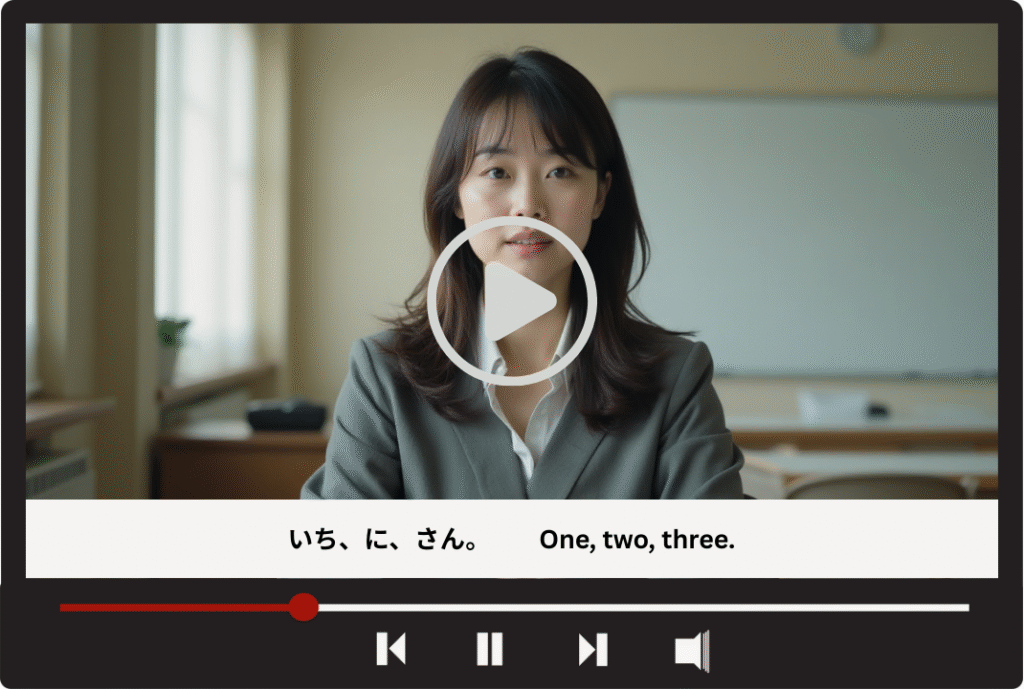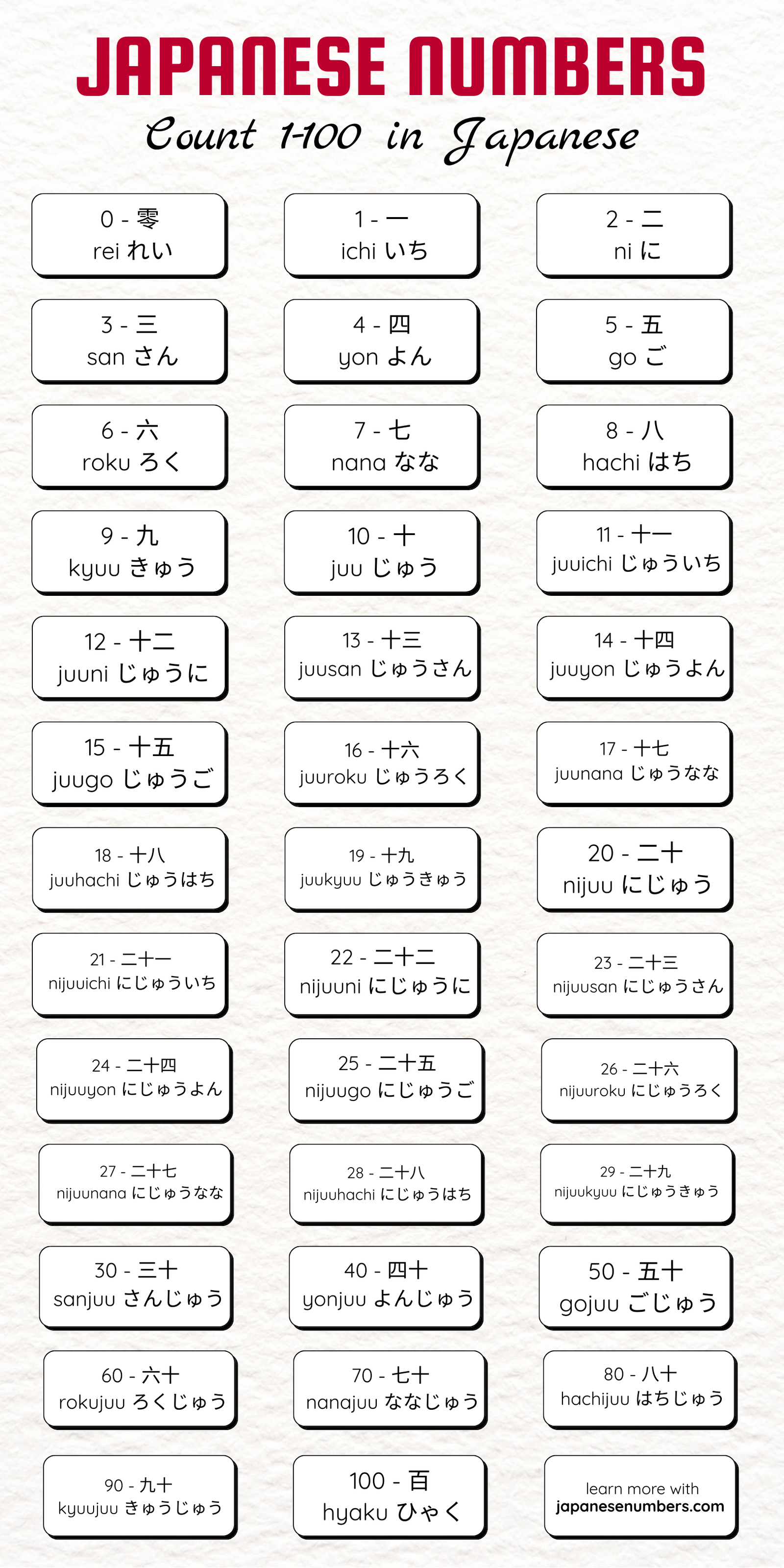Japanese Numbers and Counting in Japanese
Counting in Japanese may look confusing at first, but it follows clear patterns. Japanese uses two main systems of numbers: Sino Japanese (ichi, ni, san) and Native Japanese (hitotsu, futatsu, mittsu). You will see Sino Japanese numbers in dates, phone numbers, and math, while Native numbers are used for counting objects with counters. On this site you will practice Japanese numbers step by step, from zero to ten, then build to larger numbers, time, money, and counters for people and objects.
Start Counting in Japanese Today
Learning Japanese numbers doesn’t have to be hard. With quick videos and simple examples, you can hear, repeat, and remember faster. Each clip focuses on one phrase or number so you pick it up naturally. No long lessons, just clear and easy practice you can use right away.

Sino Japanese digits
Japanese numbers use two systems, Sino Japanese for most cases and Native forms with counters for items and people. Learn kana for sound, kanji for the character, and romaji only as a guide. The digits from zero to ten are the base for every larger number, so keep the timing even and clean. Use yon instead of shi, nana instead of shichi, and kyuu instead of ku in most speech. Play the audio on each row, repeat out loud, and do a second pass until all ten feel automatic.
| Number | Romaji | Kana | Kanji | Audio |
|---|---|---|---|---|
| 0 | rei | れい | 零 | |
| 1 | ichi | いち | 一 | |
| 2 | ni | に | 二 | |
| 3 | san | さん | 三 | |
| 4 | yon | よん | 四 | |
| 4 | shi | し | 四 | |
| 5 | go | ご | 五 | |
| 6 | roku | ろく | 六 | |
| 7 | shichi | しち | 七 | |
| 7 | nana | なな | 七 | |
| 8 | hachi | はち | 八 | |
| 9 | kyuu | きゅう | 九 | |
| 9 | ku | く | 九 | |
| 10 | juu | じゅう | 十 |

Japanese Numbers 11 to 19
Numbers from eleven to nineteen use one rule, ten plus the last digit. Eleven is juu ichi, twelve is juu ni, thirteen is juu san. Fourteen is juu yon, seventeen is juu nana, nineteen is juu kyuu. Write them as 十一, 十二, 十三, 十四, 十五, 十六, 十七, 十八, 十九, and read with even rhythm. Once these are smooth, the tens from twenty to ninety use digit plus ten.
| Number | Romaji | Kana | Kanji | Audio |
|---|---|---|---|---|
| 11 | juu ichi | じゅういち | 十一 | |
| 12 | juu ni | じゅうに | 十二 | |
| 13 | juu san | じゅうさん | 十三 | |
| 14 | juu yon | じゅうよん | 十四 | |
| 15 | juu go | じゅうご | 十五 | |
| 16 | juu roku | じゅうろく | 十六 | |
| 17 | juu nana | じゅうなな | 十七 | |
| 18 | juu hachi | じゅうはち | 十八 | |
| 19 | juu kyuu | じゅうきゅう | 十九 |
From twenty to ninety, say digit plus juu, for example ni juu, san juu, yon juu, go juu, roku juu, nana juu, hachi juu, kyuu juu. Prefer yon, nana, and kyuu for clarity, avoid shi, shichi, and ku in these tens. One hundred is hyaku, learn it as a standalone form before moving to 200 and up which have sound changes. In kanji write them as 二十, 三十, 四十, 五十, 六十, 七十, 八十, 九十, and 百. Keep the rhythm even, say the parts cleanly, and use the audio on each row until they feel automatic.
Japanese Numbers Tens and 100
| Number | Romaji | Kana | Kanji | Audio |
|---|---|---|---|---|
| 20 | ni juu | にじゅう | 二十 | |
| 30 | san juu | さんじゅう | 三十 | |
| 40 | yon juu | よんじゅう | 四十 | |
| 50 | go juu | ごじゅう | 五十 | |
| 60 | roku juu | ろくじゅう | 六十 | |
| 70 | nana juu | ななじゅう | 七十 | |
| 80 | hachi juu | はちじゅう | 八十 | |
| 90 | kyuu juu | きゅうじゅう | 九十 | |
| 100 | hyaku | ひゃく | 百 |

Japanese Numbers Complex Double Digits
Counting non round tens is simple, say the tens part then the digit, for example twenty three is ni juu san, forty nine is yon juu kyuu, fifty eight is go juu hachi, ninety seven is kyuu juu nana, and for round tens use just the tens part like ni juu or yon juu.
| Number | Formation | Kana | Romaji | Audio |
|---|---|---|---|---|
| 24 | two ten four | にじゅうよん | ni juu yon | |
| 48 | four ten eight | よんじゅうはち | yon juu hachi | |
| 57 | five ten seven | ごじゅうなな | go juu nana | |
| 68 | six ten eight | ろくじゅうはち | roku juu hachi | |
| 98 | nine ten eight | きゅうじゅうはち | kyuu juu hachi |

